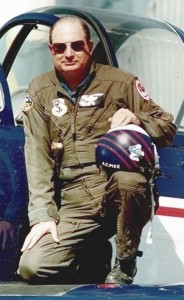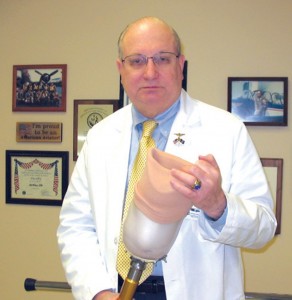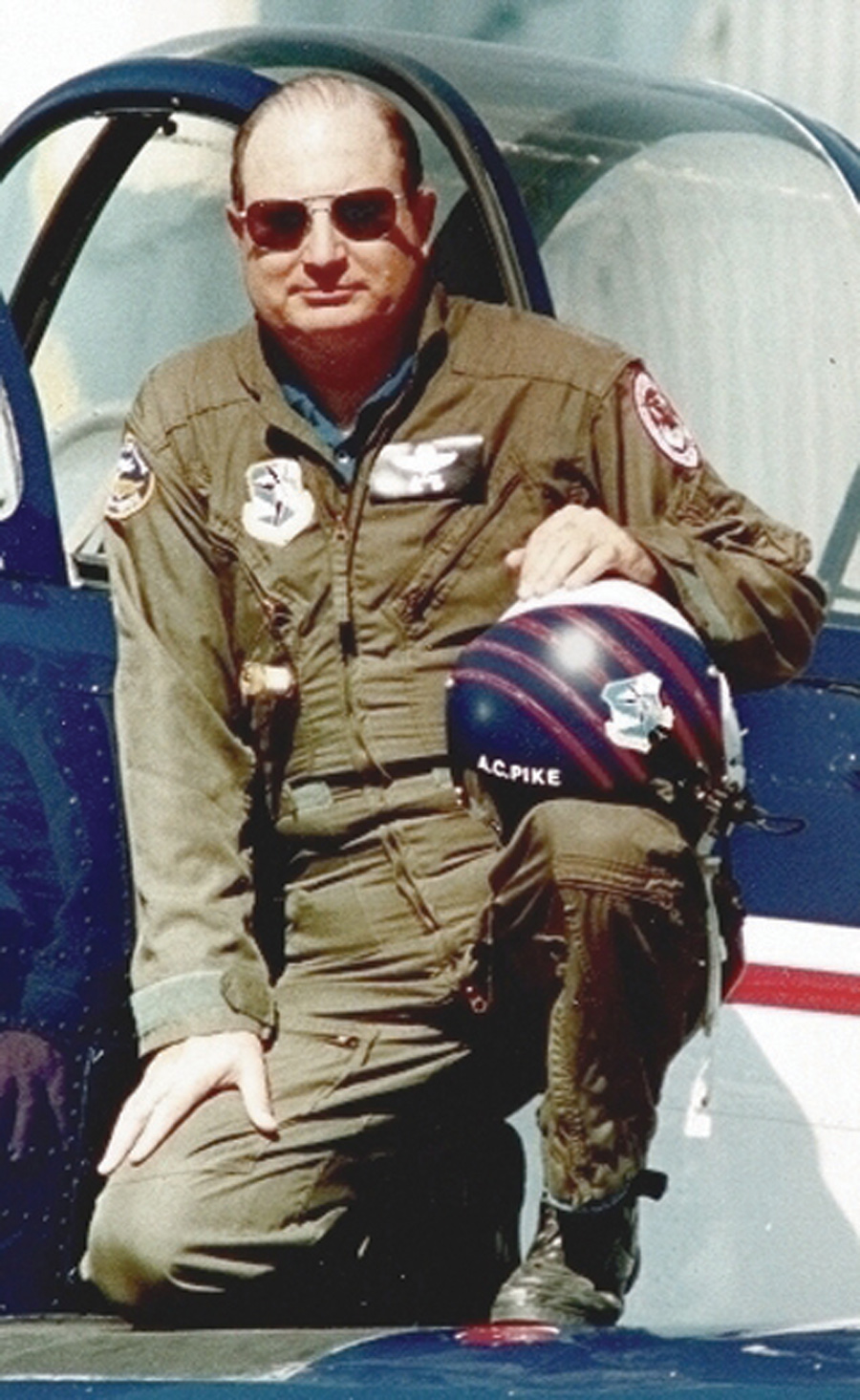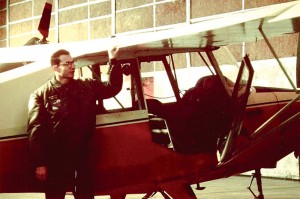By S. Clayton Moore

Al Pike balances on the wing of a T-34b, just one of the amazing aircraft he got to fly as a trainer at Planes of Fame.
Al Pike has lived many lives. As an aviator, he’s gotten to fly some of the world’s most interesting WWII aircraft, despite his imperfect eyesight. As a physician, his work in prosthetics has helped change the industry and has given him fresh insight into helping young veterans returning from the Middle East. He’s even been a Hollywood consultant, helping the creators of films like “The Fugitive” and “The Empire Strikes Back” to paint a more technically accurate picture of amputees.
Born near Jackson Army Air Base, Mississippi, in 1942, Pike moved on to Little Falls, Minn., as a child and has always had a passion for aviation.
“I guess I was born with the bug,” he said. “I’ve been building model airplanes for as long as I can remember. When we lived in Little Falls, I would find myself out at the airport watching planes take off.”
When he found out there was a Civil Air Patrol squadron in Brainerd, about 30 miles away, the young aviation enthusiast began driving his old Pontiac out for meetings. His enthusiasm led to forming a unit of the Brainerd squadron at his high school and eventually to rejuvenating Little Falls Airport.
The airport had been closed for some time,” he said. “Trying to generate some interest, I ran a small blurb in the daily newspaper about an aviation meeting in the basement of our American Legion Post. To my surprise, we got a house full of adults and things really picked up. Today, Little Falls Airport has paved runways, a new administration building and a Civil Air Patrol squadron. It’s amazing that all of that started with a bunch of high school kids dreaming of flying.”
“Unfortunately, Pike’s dreams of becoming a fighter pilot weren’t to be. Although he joined the Air Force in 1960, he soon found that his eyesight was deteriorating to the point where he didn’t qualify for pilot training. He took the loss hard.
“I was burned out on flying for a long time after that, but I got interested in medicine because of my eyesight, which eventually led me to prosthetics,” Pike said.
After serving as a medic in the Air Force, he went on to Northwestern University, to which he credits his extensive success in the field. For nearly 40 years, Pike has been a leader in the field. He’s a former president of the Amputee Coalition of America and the first recipient of the organization’s professional achievement award, honoring him for his significant impact on the lives of amputees.
“It was similar to me in many ways to building model airplanes,” he said. “I was able to work with my hands at the same time that I was helping people. The passion for me is in making a person whole again. Putting someone back on two legs and returning them to an active lifestyle is very rewarding.”
In the 1970s, Pike went to work for Minneapolis-based Otto Bock Health Care, a leading provider of prosthetic limbs and other health care technology. It was there that he had his first brushes with Hollywood. Steve Ziff, a special projects coordinator with Industrial Light & Magic, contacted Otto Bock about special myoelectric devices they could use for Luke Skywalker’s bionic arm in “The Empire Strikes Back.” Later, Ziff would ask for Pike’s help again in providing the prosthetic limbs seen at County General Hospital in “The Fugitive” as Dr. Richard Kimble, portrayed by Harrison Ford, tracks down the one-armed man.
“People start to hear about it and then they call me up to ask all kinds of questions,” Pike said. “I’ve been involved with books and movies and plays and all kinds of stuff.”
Most recently, he was a creative consultant on an independent film called “Four Feet,” starring actress and real-life amputee Shelby Robin. Pike, a film buff himself, encourages directors and producers to get away from the cinematic portrayal of amputees—the “Captain Hook” effect, he calls it—and use real amputees to greater dramatic effect.
“Why not use real amputees? They like to work, too,” he said. “More often, you get films like ‘Forrest Gump’ using special effects instead of showing amputees the way they really are. The coroner in ‘CSI’ is played by Robert David Hall, who is terrific, and Anita Hollander from ‘The Sopranos’ is a great actress. Let’s get some positive role models out there.”
One good example the prosthetist points to is last year’s dramatic portrayal of B.D., a character in Garry Trudeau’s Doonesbury comic strip, who loses a leg in Iraq. More recently, Pike’s duties as a prosthetist-orthotist at the Veterans Affairs Medical Center in Minneapolis has tied his interests in both the military and medicine together in a challenging way. The hospital is treating young soldiers with combat injuries straight from Iraq and Afghanistan.
“I do get kind of emotional about the kids coming back from the war,” he said. “These guys are family in a sense. I’m a veteran myself and this place is about veterans taking care of veterans. It’s important.”
Although the thousands of amputees coming back are heartbreaking, Pike explained that it’s helping to further research in the field, with a level of innovation that hasn’t been seen since World War II.
As an advocate for amputee patients, Pike formed the Amputee Resource Foundation of America, and serves as president and CEO. He helps patients cope with the psychological impacts of amputation, and educates doctors in the science of it.

As a prosthetist-orthotist with the Veterans Affairs Medical Center in Minneapolis, Al Pike has been at the leading edge of both treatment of amputees and research into new mobility options.
“There are very few surgeons who really understand amputation surgery,” he said. “They see it as destructive and they feel hurt by the fact that they didn’t save the limb. That’s something we’ve been battling for years. Surgeons need to think more positively about amputating the limb right so we can build a good prosthesis and do everything we can to give a person a positive foundation.”
By the 1980s, Pike had almost completely given up his flying except for a few hours playing on the new flight simulator software for personal computers, but on a whim, he stopped by Minnesota’s Crystal Airport one afternoon.
“There was an old FBO there, and I paid for a $20 dollar intro flight. I taxied down the runway as usual and the instructor asked me if I’d ever flown before. I told him I hadn’t touched a plane since the 1960s. He let me take the plane down the runway, and about 500 feet off the ground, he accused me of being a liar!” he chuckled. “I was pretty surprised that I was still able to handle an airplane pretty good. He told me I definitely hadn’t lost my touch.”
He ended up taking ground school as a Christmas present from his wife, Carol Ann. He eventually got involved with Robert Pond’s pet project, the Planes of Fame East, an air museum in Eden Prairie, Minn., where Pond kept his massive collection of WWII combat aircraft for years. Pike served on the museum’s executive committee and oversaw its famous air show program for three years.
“I nearly killed myself the first year trying to run everything, but by the next year, I had the structure laid out on the computer and learned to use team leaders for different areas,” he said. “It got a lot more organized and there was a time when we were really the pinnacle in the Midwest for running air shows.”
He also combined his love of flying and film to produce incredible footage of the air shows. Although the museum closed in 1997, Pike still remembers it as one of the remarkable periods of his life. He got to fly Pond’s B-25 and B-17, T-6s and T-34s, as well as meeting aviation legends like Chuck Yeager, Tony LeVier, Gabby Gabreski and Joe Foss. For a pilot who got cut from flight training, he flew some amazing aircraft.
“I remember coming in from Oshkosh one year in the right-hand seat of the B-17. I was flying across Wisconsin at about 3,000 feet with two Mustangs on my wing,” Pike remembered. “We really put our heart into Planes of Fame and I was able to do things I never thought I would get to do in my lifetime.”
He also remembers fondly the camaraderie he enjoyed with the pilots and other aviation enthusiasts who participated in air shows around the country.
“We would have a great time flying out to an air show,” he said. “We would then come back here to the Lion’s Tap in Minneapolis to celebrate making it back in one piece, for starters. To this day, we’re family. It wasn’t just a bunch of buddies and their planes; it really was a close-knit group.”
Pike still enjoys going to local air shows as well as his professional responsibilities lecturing on prosthetics and raising money for research. He hopes to write a book about his career in the artificial limb trade and has absolutely no regrets about his adventures in aviation or medicine. For Pike, the rewards have outstripped the challenges by a mile.
“These are the things that dreams are made of,” Pike said fondly. “When I was flying with Planes of Fame, we always said that if we ever went upstairs, it would be a lateral move.”
For more information on the Amputee Resource Foundation of America, visit [http://www.amputeeresource.org].












